|
|
|
Sort Order |
|
|
|
Items / Page
|
|
|
|
|
|
|
| Srl | Item |
| 1 |
ID:
133485
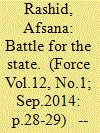

|
|
|
|
|
| Publication |
2014.
|
| Summary/Abstract |
With the State Assembly elections round the corner, mainstream political parties and separatists here are gearing up with their respective agendas. Many new political equations and alliances are expected to come to the fore in the upcoming polls, in Jammu and Kashmir, slated at the end of this year.
The contest will be close for several stalwarts and many new faces will emerge on the political horizon of the state. Though bijli, pani and sadak (electricity, water and roads) will remain the main focus of the election manifesto of several political parties, resolution of Kashmir issue, abrogation of Article 370 (that provides special status to the state of Jammu and Kashmir) and rehabilitation for Kashmiri Pandits will find equal importance on their respective agendas. Prof. Farooq Fayaz, a prominent historian, author and director Academic Staff College, University of Kashmir, observes that apart from focusing on good governance, all political parties have their own roadmaps to follow
|
|
|
|
|
|
|
|
|
|
|
|
|
|
|
|
| 2 |
ID:
132813
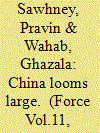

|
|
|
|
|
| Publication |
2014.
|
| Summary/Abstract |
India's national security, especially its defence preparedness against Pakistan and China, with whom it has disputed border, is passing through a disturbing phase. Pakistan continues with cross border terrorism into Jammu and Kashmir, while China infringes upon Indian land and air space from Ladakh to Arunachal Pradesh at will. Both have made a mockery of the military-held lines with India.
Speaking in Parliament during the recent budget session, defence minister Arun Jaitley expressed satisfaction regarding the two disputed borders. According to him, the Indian Army has minimised infiltration across the Line of Control and terrorism in the hinterland with a mix of good anti-infiltration deployment, monitoring and surveillance means, and the fence. Chinese intrusions, he said, are because of differing perception of the disputed border by the two countries.
Do we want better detection and elimination of terrorists in Kashmir, or do we want to compel Pakistan to stop infiltration? If India does not intrude into Chinese land, why should China do this to India regularly?
India seems to have accepted low defence thresholds against both neighbours. This is worrisome. If Pakistan and China are not deterred by India and its military power, especially boots on the ground, will India's two-front war strategy work to compel them? Why is India spending nearly USD 49 billion annually, which excludes defence pensions and nuclear weapons capability, on defence when it appears blunted? Is there a way out for India without going to war with either or both?
India needs a transformation of its national security and defence thinking. It must know that China rather than Pakistan is its irreconcilable adversary, and the disputed border with China is India's singular core concern which impedes India's rise. Once this is grasped, a new approach to policy-making and warfare would emerge. China could be balanced by a political-military methodology, while peace could be made with Pakistan. India's warfare practised so far would alter drastically. With China as the main adversary, India would no longer be preparing to fight the last war better. With more domains like space, cyber, ballistic and cruise missiles, irregular warriors (terrorists) and nuclear weapons added to the conventional combat on land, air and sea, India will need different higher defence organisation and higher strategic organisation from those proposed so far. All this can be done without raising either annual defence allocations or ringing alarm bells in the region.
|
|
|
|
|
|
|
|
|
|
|
|
|
|
|
|
| 3 |
ID:
131135
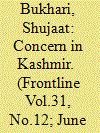

|
|
|
|
|
| Publication |
2014.
|
| Summary/Abstract |
The controversy over Article 370 has affected the psyche of the average Kashmiri and give rise to the fear that certain important right that the people of the state enjoy are going to be snatched away.
|
|
|
|
|
|
|
|
|
|
|
|
|
|
|
|
| 4 |
ID:
128513
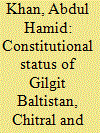

|
|
|
|
|
| Publication |
2013.
|
| Summary/Abstract |
Before the partition of the Indian sub-continent, the British handed over the tiny states including Yasin, Punial, Gupis, Ishkoman, Gilgit, Nagar, Hunza, Astore and Chilas to the Maharaja of Kashmir. Chilas was under the suzerainty of Yasin even after 1947. Before 1860, Mastuj (now part of Chitral), Gupis and Ishkoman were also integral parts of Yasin. After the murder of British spy Col. George Hayward by the Yasin ruler Mir Wali in 1873, differences between the State of Yasin and the British government had deepened. The British reacted by separating Mastuj, Koh Ghizer, Gupis and Ishkoman from Yasin. Rundu, Kharmang, Skardu, Ladakh and Astore remained under the direct control of Maharaja of Jammu and Kashmir. Before the partition of India, the Maharaja of Kashmir, on 1 August 1947, took over the administration of the entire Gilgit-Baltistan, i.e., former Gilgit Wazarat north of the Indus and all political districts. The area together with Bonji formed the Gilgit frontier province. Maharaja of Kashmir appointed Brigadier Ghansara Singh as the Governor, and also sanctioned the budget for the Gilgit frontier province.
|
|
|
|
|
|
|
|
|
|
|
|
|
|
|
|
| 5 |
ID:
132260
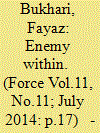

|
|
|
|
|
| Publication |
2014.
|
| Summary/Abstract |
This year the Indian Army achieved a major success by killing 41 militants including 11 top commanders of Lashkar-e-Toiba (LeT), Jaish-e-Mohammad (JeM) and Hizbul Mujahideen (HM) and arrested 23 of them in joint operations with the police.
The figures reveal that this is more than the number of militants neutralised last year, but over the years killing of militants is not making much of a difference as new recruits replace them.
Lieutenant General Subrata Saha, who took over as the General Officer Commanding (GOC) of Army's strategic Chinar Corps or 15 Corps, responsible for tackling militancy in Kashmir besides guarding the Line of Control (LC), has a bigger challenge ahead. For him, killing the militancy is a challenge and not counting the dead.
As per the figures given by the Jammu and Kashmir Police, there are 130 active militants in Kashmir valley and if the rate at which they were eliminated this year continues, not a single militant will be left by next year.
Says a senior army officer: "That is not the case, as per our records at least 16 Kashmiri youth, mostly educated, joined militancy this year. The numbers could be more than our records. And on an average two-three youth get lured into militancy during the funeral of a militant commander."
|
|
|
|
|
|
|
|
|
|
|
|
|
|
|
|
| 6 |
ID:
131137
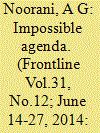

|
|
|
|
|
| Publication |
2014.
|
| Summary/Abstract |
The BJP's long running pledged for the abrogation of Article 370, for a Ram temple in Ayodhya, and for a uniform civil code are constitutionally impossible to fulfil politically divisive and morally outrageous.
|
|
|
|
|
|
|
|
|
|
|
|
|
|
|
|
| 7 |
ID:
132262
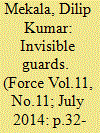

|
|
|
|
|
| Publication |
2014.
|
| Summary/Abstract |
A wide variety of state-of-the-art UGS systems are now available in the market
The use of unattended ground sensors (UGS) for border security applications has gained momentum in recent times across the world. For India, where the border guarding forces face significantly large number of challenges manning the open and porous borders, the UGS could provide a perfect solution. It is no surprise that Indian armed forces are now in the process of procuring these advanced sensors.
The ministry of home affairs (MHA) had issued an expression of interest (EoI) in 2013 to procure UGS systems for Border Security Force (BSF). This initiative from the MHA came after the reports of a 400 metre long tunnel was found in Jammu and Kashmir close to the international border. "Hand-held control receiver and variety of sensors like, passive infrared sensor to detect movement of object in a narrow field of view, magnetic sensors to monitor movement of metallic objects such as weapons or vehicles and seismic sensors to identify ground vibration caused by vehicles or pedestrians (should be encompassed in the device)," stated the qualitative requirements floated by the Paramilitary.
|
|
|
|
|
|
|
|
|
|
|
|
|
|
|
|
| 8 |
ID:
130889
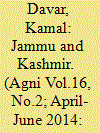

|
|
|
|
|
| Publication |
2014.
|
| Summary/Abstract |
The crown of India, the divinely beautiful and immensely strategic state of Jammu and Kashmir since its tumultuous accession to the Indian union in 1947, displayed at times, the pangs of an uneasy existence with the secular, liberal and generous environs of the parent nation. That is abiding emotional integration to Mother India, is still wanting in some spheres, even after 66 years of togetherness, is hardly a tribute to India's and the state's political leadership or governance notwithstanding the countless sacrifices made, monumental aid and resources invested for the security and development of India's restive northernmost state. That India's ever belligerent neighbor, Pakistan has left no stone unturned or any machination in the book to fan separatism in J&K which is considers its jugular vein is hardly surprising. In the globally troubled times of today, Pakistan and some others in the world forget that India is home to the third largest population in the world and thus J&K is not a mere symbol of India's secularism but its prime guarantee.
|
|
|
|
|
|
|
|
|
|
|
|
|
|
|
|
| 9 |
ID:
131021
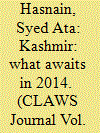

|
|
|
|
|
| Publication |
2014.
|
| Summary/Abstract |
Kashmir was some years ago perceived as an open and shut case where terrorism needed to be swamped and all would return to normal. That usually is a perception which prevails about most internal conflict situations when they are at the peak of conflict progression in terms of ?ghting and other military related activities. Solutions are seldom looked at comprehensively as militaries get self-obsessed with controlling the quantum of violence. Their goals usually remain limited to the subjugation of violence and creation of the much sought after threshold from \\-'here a political process can proceed. That can happen in internal conflicts which are stand-alone and where linkages are limited. In the case of Kashmir, it is questionable whether the con?ict is internal in nature at all because of the deep-set up for linkages which extend to our neighbourhood
|
|
|
|
|
|
|
|
|
|
|
|
|
|
|
|
| 10 |
ID:
124697
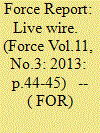

|
|
|
|
|
| Publication |
2013.
|
| Summary/Abstract |
After a long peace since the ceasefire came into being on 26 November 2003, the International Border (IB) in Jammu witnessed numerous ceasefire violations in 2013. Unlike the Line of Control (LC) which has seen innumerable ceasefire violations each year, with as many as 250 in 2013 alone, the IB getting live was unusual. The firings intensified since August causing loss of lives and property to civilians, who unlike the LC, live close to the IB. This unexpected activity got the Jammu and Kashmir chief minister, Omar Abdullah, to say that India should exercise options to silence Pakistani firing. Matters, however, finally settled on the IB with the recent meeting of the Border Security Force (BSF) and its counterpart, the Pakistani Chhamb rangers in R.S Pura sector. At sector commanders' level, both the sides agreed to maintain ceasefire and restore issues through negotiations.
|
|
|
|
|
|
|
|
|
|
|
|
|
|
|
|
| 11 |
ID:
126019
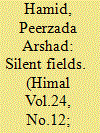

|
|
|
|
|
| Publication |
2011.
|
| Summary/Abstract |
Surankot is a small dusty frontier town of Poonch district in Jammu & Kashmir. A row of decrepit concrete constructions - the town's marketplace - stand face to face on the both sides of a narrow, potholed road. At the end of this line of shops, a bend in the road leads to the police station and an Indian Army cantonment. A stone's throw further is a graveyard containing unmarked graves, with bodies unknown to the resident
|
|
|
|
|
|
|
|
|
|
|
|
|
|
|
|
| 12 |
ID:
129373
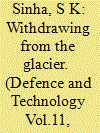

|
|
|
|
|
| Publication |
2012.
|
| Summary/Abstract |
In July 1949, the UN delegation led by Hernando Sampiers from Columbia convened an Indo Pak conference at Karachi to lelineate the ceasefire line in Kashmir
|
|
|
|
|
|
|
|
|
|
|
|
|
|
|
|
|
|
|
|
|